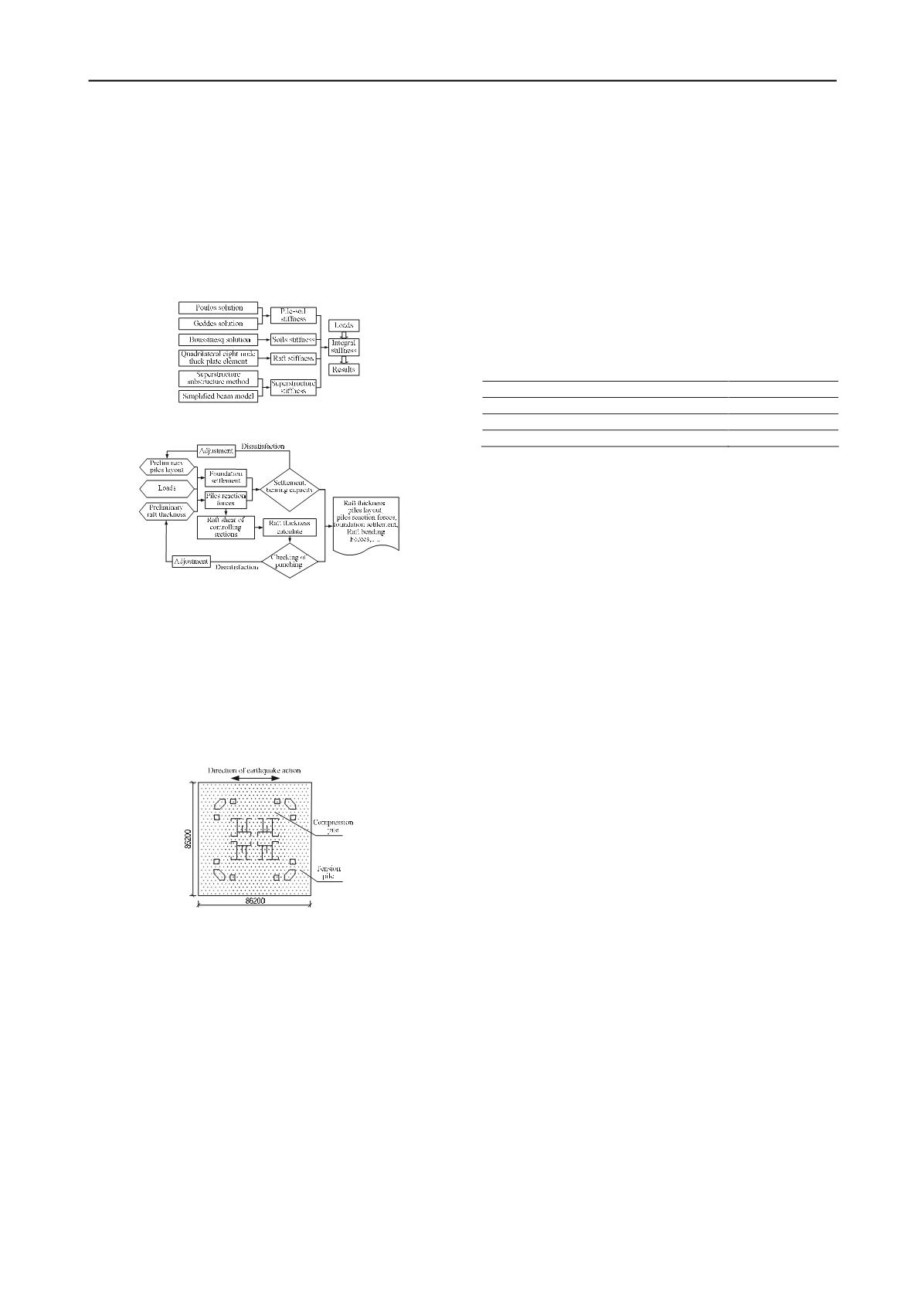
2900
Proceedings of the 18
th
International Conference on Soil Mechanics and Geotechnical Engineering, Paris 2013
calculation of the raft, punching and shearing capacities
calculation of the raft. The wind and earthquake actions need to
be considered in the process of design calculation of the pile
foundation for high rise building. The following load cases
should be considered in the design. (1) Gravity load (dead load
and live load); (2) Combination of gravity load and wind load;
(3) Combination of gravity load and frequently earthquake load;
(4) Combination of gravity load, wind load and frequently
earthquake load; (5) Combination of gravity load and
fortification intensity earthquake load.
Figure 4 Theoretical framework and procedures of a practical method
for analysis and calculation of pile foundation
Figure 5 A general design calculation process of pile foundation
The lateral forces imposed by wind load and earthquake
action may be very high for super high-rise buildings. When the
eccentric vertical forces caused by wind load and earthquake
action were accounted for in the design calculation process of
the pile foundation, the characteristic value of the vertical
bearing capacities of the piles can be increased about 20% and
50%, respectively. Moreover, if tension and compression zones
generate in the foundation caused by the action of earthquake,
for example as shown in Figure 6, the tension and compression
bearing capacities of the piles in those zones should be checked.
Figure 6 Distribution of tension and compression zones in the pile
foundation of the Tianjin 117 Tower under the earthquake action
7 KEY CONSTRUCTION TECHNIQUES AND PILE
QUALITY INSPECTION
Suitable drilling machine, techniques and some other auxiliary
measures are key factors for successful construction of super
long bored piles. Slewing drilling machine can be used in soft
soils. But in the hard soils or soft rock layers, the construction
efficiency of rotary drilling rig is higher than that of Slewing
drilling machine. For example, in the Wuhan Tower project,
which site soil stratigraphy consists of some dense slit, sand and
moderately to slightly weathered mud rock within the drilling
depth, about 79 hours were saved to construct a single pile
when the rotary drilling rig was used instead of slewing drilling
machine. Different types of rotary drilling rig bit can be selected
for different soils in the borehole depth range. Different drilling
machines can be combined to drill the boreholes in the
complicated project site. For example, in the Wuhan Green
Land Tower project, the rotary drilling rig was adopted for clay,
sand and intense weathered mud rock layers, while the slightly
weathered mud rock and sand rock were drilled by percussion
drilling machine. In the process of the borehole drilling, sand
content in the drilling fluid should be strictly controlled.
Moreover, the density of the drilling fluid should be increased
appropriately to ensure the stability of the super deep borehole
wall. For example, in the Shanghai Center Tower project, the
boreholes need to be drilled through about 60m thick sand
layers. The indexes of the drilling fluid used in this project are
shown in Table 3. If the borehole is very deep or located in
coarse grained soil layers, the technique of pump suction or air-
lift reverse circulation need to be utilized in the drilling
construction process.
Table 3 Drilling fluid indexes of the Shanghai Center Tower project
index
Value
Density (g/cm
3
)
1.1~1.2
Viscosity (s)
16~20
Sand content (%)
<4
Inspection and controlling standards of super-long bored
piles are stricter than those of ordinary piles. Quality of the piles
should be controlled in the process of construction. The
borehole quality, including depth, diameter, verticality and
sediment, need to be comprehensively inspected. The number of
boreholes to be inspected should be not less than 30% of the
total number of boreholes. The pile shaft quality should be
evaluated mainly by sonic logging and core drilling methods.
The number of piles to be inspected should be larger than 10%
of the total number of engineering piles.
8 CONCLUSIONS
According to a great number of engineering practices of super-
long bored pile foundations for super high-rise buildings in
China, the paper systematically describes some key technical
measures of design and construction of the super-long bored
pile foundation together with a briefly summary of the bearing
behaviors of the super-long bored pile. Post grouting technique
is recommended for the super-long bored pile. Deep buried
solid soils are usually selected for the pile tip bearing stratum.
Application of the double steel sleeves, design of the pile top,
construction and measurement requirements are essential issues
that should be considered in the design of the field load test pile.
Design calculation of the pile foundation should consider the
synergism of the superstructure, soils and pile foundation.
Inspection and controlling standards of super-long bored piles
are stricter than those of ordinary piles. Quality of the piles
should be controlled in the process of construction.
9 REFERENCES
Wang, W.D. Zhu, H.H and Li, Y.L. 2011. Urban geotechnical
engineering and new technology. Chinese Journal of Undergrouond
Space and Engineering, 7(s1): 1274-1291 (in Chinese).
Poulos, H.G. 2009. Tall building and deep foundations-Middle East
challenges. Proceeding of the 17th International Conference on Soil
Mechanics and Geotechnical Engineering, Alexandrie, Egypte,
Volume 4: 3173-3205.
Zhang, Y. and Liu, J.B. 2009. Pile Foundation Handbook, China
Building Industry Press, Beijing (in Chinese).
Wang, W.D., Li, Y.H. and Wu, J.B. 2011. Field loading tests on large-
diameter and super-long bored piles of Shanghai Center Tower.
Chinese Journal of Geotechnical Engineering, 33(12): 1817-1826
(in Chinese).
Wang, W.D., Li, Y.H. and Wu, J.B. 2012. Reply to disscussion on
“
Field loading tests on large-diameter and super-long bored piles of
Shanghai Center Tower
”
. Chinese Journal of Geotechnical
Engineering, 34(6): 1167-1168 (in Chinese).


